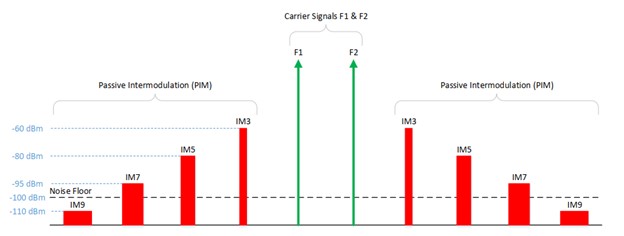What Is PIM Mitigation?
_2.jpg?ext=.jpg?width=950)
Why Does PIM Mitigation Matter?
In order for a wireless system to function properly, technicians must determine and fix any internal or external factors that are affecting the quality of the connection. PIM is often one of the factors that should be analyzed in these cases.
PIM is interference created by Transmitting (Tx) signals at a cell site due to internal or external factors.

PIM is created by nonlinear behavior within these passive components (internal or external to the system), which generates unwanted signals, referred to as IM3, IM5, IM7, etc. These IM frequencies are essentially the Intermodulation Harmonics created from the downlink carrier signals. The goal to mitigate PIM is to increase the Linearity of the system and its components.
A PIM Tester essentially simulates two carrier signals (F1 and F2) and measures the IM3 response from the system. The IM3 response indicates the linearity of the system with IM3 Low meaning good linearity and IM3 High meaning bad linearity.

This test set up is good for isolating and troubleshooting the internal factors causing PIM, but external factors outside of this cable & antenna system could still affect measurements and result in high IM3. Additional testing can be done, using a PIM hunting probe with a filter and a spectrum analyzer as seen below:

This PIM Test Setup allows the user to easily find the PIM source that is external to the cable and antenna system. The source of PIM created outside the system can be visualized with the PIM hunting probe. The filter used is specified by the F1 and F2 carrier signals that are being tested. The IM3 that is being measured is calculated based off the F1 and F2, making the selection of test equipment to be straight forward.
Locating external PIM can be a challenge, and PIM mitigation is key to a successful wireless communication system. ATEC provides all the equipment needed to accomplish this including:


What is Passive Intermodulation (PIM)?
PIM can cause connectivity problems and affect the quality of a wireless system. Using a variety of PIM Test Equipment can help troubleshoot cable & antenna systems to increase performance. Internal factors can be loose connections, metal shavings within connectors, or dirty connectors. These issues are usually easier to test and detect. External factors could be a variety of things which are harder to pinpoint. This could include anything from an antenna mast mounting bracket, to a metal coin on the ground near the antenna.
PIM is created by nonlinear behavior within these passive components (internal or external to the system), which generates unwanted signals, referred to as IM3, IM5, IM7, etc. These IM frequencies are essentially the Intermodulation Harmonics created from the downlink carrier signals. The goal to mitigate PIM is to increase the Linearity of the system and its components.
PIM Mitigation
Avoiding PIM is key in a effective wireless communication system, as users of communication devices are affected by bad cellular service. This problem can result in potentially larger battery draining for devices. ATEC stocks a variety of test equipment including PIM testers, cable & antenna analyzers, PIM blankets, PIM hunting probes, and handheld spectrum analyzers to enable PIM mitigation. PIM mitigation occurs when operators seek to minimize and reduce the PIM affecting a system.How to Reduce PIM?
The simple answer to reduce PIM is to increase linearity. Linearity is measured by using a PIM Tester. First, a basic RF sweep on the cable & antenna system is done to verify the VSWR is within specification. This initial step can help identify faulty components at the start, which could potentially be causing PIM. Once the system has been verified to have low return loss, a PIM test can be performed.A PIM Tester essentially simulates two carrier signals (F1 and F2) and measures the IM3 response from the system. The IM3 response indicates the linearity of the system with IM3 Low meaning good linearity and IM3 High meaning bad linearity.

Typical PIM Test Set Up
For basic testing of the cable & antenna system, the PIM tester is connected directly to the cable or antenna of the system, using a low PIM test port cable, usually with 7/16 DIN or 4.3-10 connectors.

This PIM Test Setup allows the user to easily find the PIM source that is external to the cable and antenna system. The source of PIM created outside the system can be visualized with the PIM hunting probe. The filter used is specified by the F1 and F2 carrier signals that are being tested. The IM3 that is being measured is calculated based off the F1 and F2, making the selection of test equipment to be straight forward.
ATEC's PIM Mitigation Solutions
- PIM Testers
- Cable & Antenna Analyzers
- Handheld Spectrum Analyzers
- PIM Hunting Probes
- PIM Accessories – Including PIM Blankets, RF Adapters, and More
Anritsu Field Master Pro MS2090A



